
Electric Cars vs. Traditional Vehicles: Which One Fits Your Lifestyle?
The automotive industry is in the middle of a major transformation. For decades, traditional vehicles powered by internal combustion engines (ICE) dominated roads worldwide. But with the rise of electric cars (EVs), many consumers are now faced with an important question: which type of vehicle truly fits their lifestyle—electric or traditional?
The answer isn’t always straightforward. Both electric cars and traditional vehicles offer unique benefits, challenges, and costs that affect how well they align with your daily needs. To help you make an informed decision, this guide breaks down the key differences between electric and traditional vehicles, exploring their performance, costs, environmental impact, and long-term practicality.
1. Performance: Power and Driving Experience
Electric Cars
EVs are known for their instant torque, which translates into quick acceleration and a smooth driving experience. Without gears and with fewer moving parts, they often deliver a quieter, more refined ride. Many drivers are surprised by how responsive electric cars feel compared to gas-powered vehicles.
- Pros: Instant acceleration, quiet ride, smooth handling.
- Cons: Limited top speed compared to performance-focused ICE cars.
Traditional Vehicles
Gasoline and diesel cars provide a familiar driving feel. They often have higher top speeds, and performance vehicles in particular can deliver impressive horsepower. However, ICE cars rely on transmissions and gear shifts, which can sometimes feel less smooth than the seamless nature of EVs.
- Pros: Wide variety of performance options, high-speed capabilities.
- Cons: Slower acceleration in most standard models, noisier engines.
2. Cost of Ownership
Electric Cars
The initial purchase price of EVs has historically been higher than that of traditional cars, but prices are steadily dropping. When factoring in government incentives, the upfront cost gap is narrowing. The real savings come with operating costs: charging an EV is cheaper than refueling with gasoline, and EVs have fewer parts to maintain.
- Lower Maintenance: No oil changes, fewer moving parts, less frequent brake replacements.
- Fuel Savings: Electricity costs less than gas in most regions.
- Battery Replacement: Still a concern, though modern EV batteries are designed to last 8–15 years.
Traditional Vehicles
ICE cars generally have lower upfront prices, especially in budget models, and a wider range of options on the market. But long-term ownership costs can be higher due to fuel expenses and routine maintenance.
- Maintenance Needs: Oil changes, transmission services, exhaust system repairs, and more.
- Fuel Costs: Rising gas prices continue to make traditional vehicles less affordable in daily use.
- Resale Value: Still strong, though EVs are catching up.
3. Environmental Impact
Electric Cars
EVs are widely praised for their eco-friendly nature. By producing zero tailpipe emissions, they significantly reduce local air pollution. The environmental footprint of EVs mainly comes from battery production, but as renewable energy sources power more electricity grids, EVs are becoming a cleaner option overall.
- Pros: Zero emissions while driving, reduced reliance on fossil fuels.
- Cons: Environmental impact of battery mining and disposal.
Traditional Vehicles
ICE vehicles contribute heavily to carbon emissions and air pollution, making them less sustainable in the long run. Even with more efficient engines, they still burn fossil fuels and contribute to climate change.
- Pros: None from an emissions perspective.
- Cons: High carbon footprint, air pollution, reliance on oil.
4. Convenience and Refueling
Electric Cars
One of the main challenges for EVs is charging infrastructure. While charging stations are becoming more common, they may not be as readily available as gas stations, especially in rural areas. Charging at home overnight is the most convenient option for EV owners.
- Charging Time: Fast chargers can add 80% charge in 20–40 minutes, but standard charging takes several hours.
- Best for: People with access to home charging and predictable daily commutes.
Traditional Vehicles
Gas stations are everywhere, and filling up takes just a few minutes. For long road trips or people with irregular schedules, ICE cars offer unmatched convenience.
- Refueling Time: 5 minutes or less.
- Best for: Long-distance drivers, rural areas with limited EV infrastructure.
5. Range and Reliability
Electric Cars
Range anxiety—the fear of running out of charge—has been a major concern for EV drivers. However, newer EVs now offer ranges between 250 and 400 miles per charge, which is more than enough for most daily commutes. Reliability is another strong point since EVs have fewer mechanical parts that can fail.
- Pros: Dependable, fewer breakdowns, long-term durability.
- Cons: Still less range than some gas-powered vehicles, long recharge times on trips.
Traditional Vehicles
ICE cars typically have ranges of 400–600 miles on a full tank, making them ideal for long journeys. They can also be refueled quickly, which gives them an edge over EVs in terms of convenience for road trips. However, with more moving parts, ICE cars are more prone to wear and tear.
- Pros: Longer driving range, fast refueling.
- Cons: Higher maintenance risks over time.
6. Lifestyle Fit
Choosing between an EV and a traditional car largely depends on your personal lifestyle and driving habits.
- Urban Drivers: EVs make sense in cities with access to charging stations. Quiet rides and zero emissions are perfect for stop-and-go traffic.
- Commuters: If you have a consistent commute and can charge at home, EVs save money and time in the long run.
- Road-Trippers: Traditional cars still hold the advantage if you frequently travel long distances where charging stations are scarce.
- Budget Buyers: Traditional vehicles often provide cheaper upfront costs, while EVs save more over the long term.
- Eco-Conscious Consumers: EVs align better with sustainable living and reducing carbon footprints.
7. Technological Advancements
Electric Cars
EVs often come with cutting-edge technology, from connected apps to autonomous driving features. Many EVs receive over-the-air software updates, improving performance and adding new features even after purchase.
Traditional Vehicles
While ICE cars also offer advanced infotainment and safety systems, they lack the level of digital integration and adaptability that EVs provide.
8. Resale Value and Market Trends
The automotive market is shifting toward electrification. Many countries are even setting deadlines to phase out sales of new gasoline vehicles. This means EVs are gaining market share, while traditional cars may lose long-term resale value as regulations tighten.
- EVs: Rapidly growing demand, improving resale values.
- ICE Cars: Still strong in the short term, but may decline as bans and restrictions increase.
9. Insurance Considerations
Insurance for EVs can be slightly more expensive due to the high cost of batteries and repairs. However, as EV adoption grows, insurers are adjusting rates. Traditional cars tend to have lower insurance costs but may rise with higher accident risks and repair needs.
10. The Future Outlook
Looking ahead, the future of transportation is electric. Governments, manufacturers, and consumers are aligning toward sustainability and cleaner technologies. While traditional vehicles won’t disappear overnight, their dominance is slowly waning as EVs become more affordable, practical, and widely available.
Conclusion
The decision between electric cars vs. traditional vehicles ultimately comes down to your lifestyle, driving habits, and values. If you prioritize sustainability, lower long-term costs, and cutting-edge technology, an electric vehicle is likely the better fit. On the other hand, if convenience, long-range driving, or upfront affordability are most important, a traditional vehicle still makes sense.
As we move further into the 2020s, the automotive landscape will continue to evolve. Whichever option you choose, staying informed about these trends ensures your decision is aligned not just with your current lifestyle—but also with the future of mobility.

